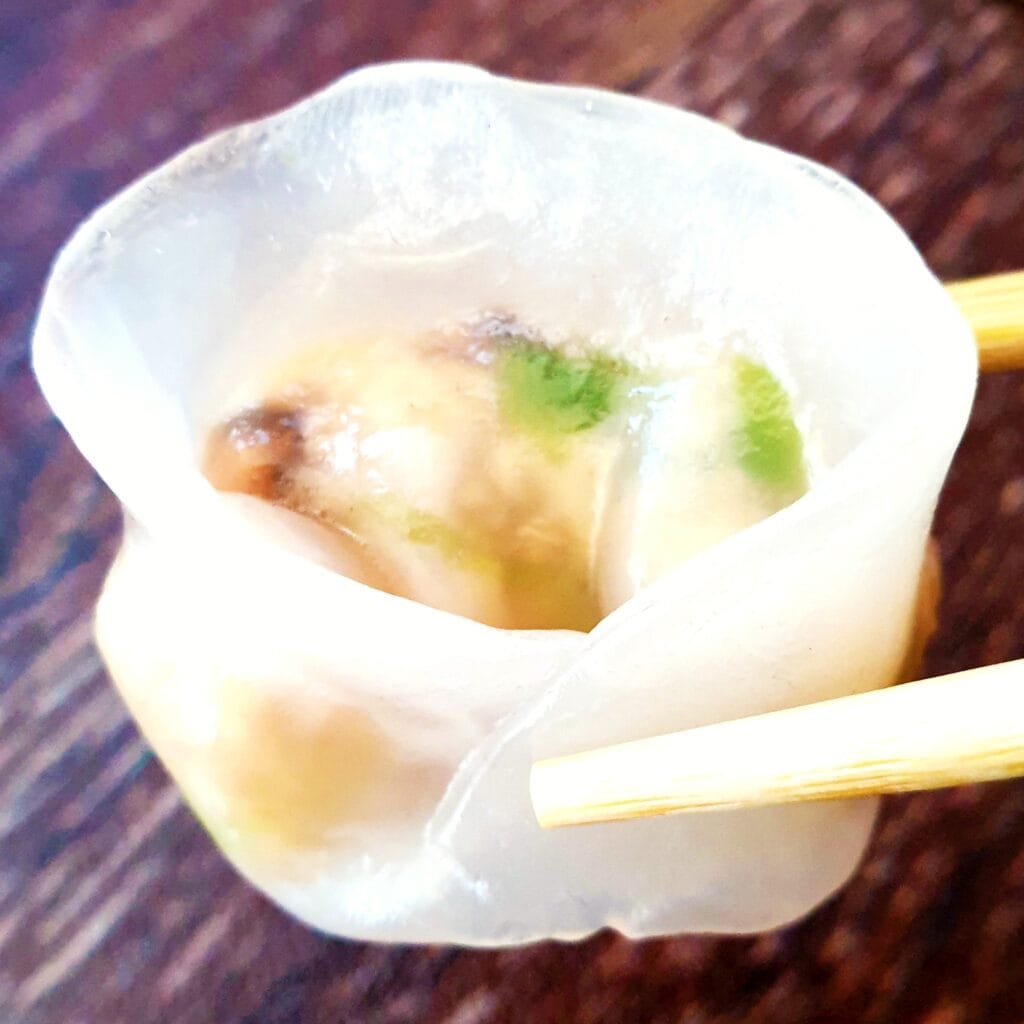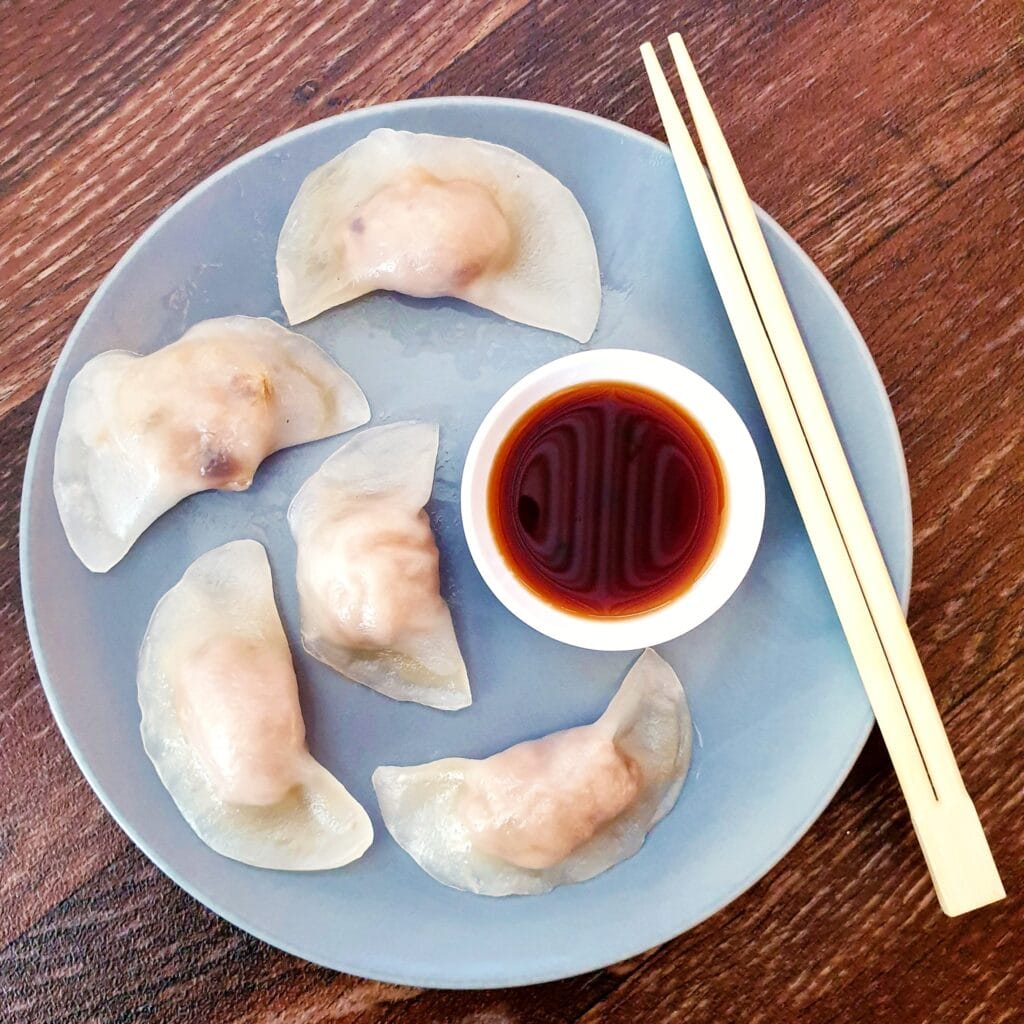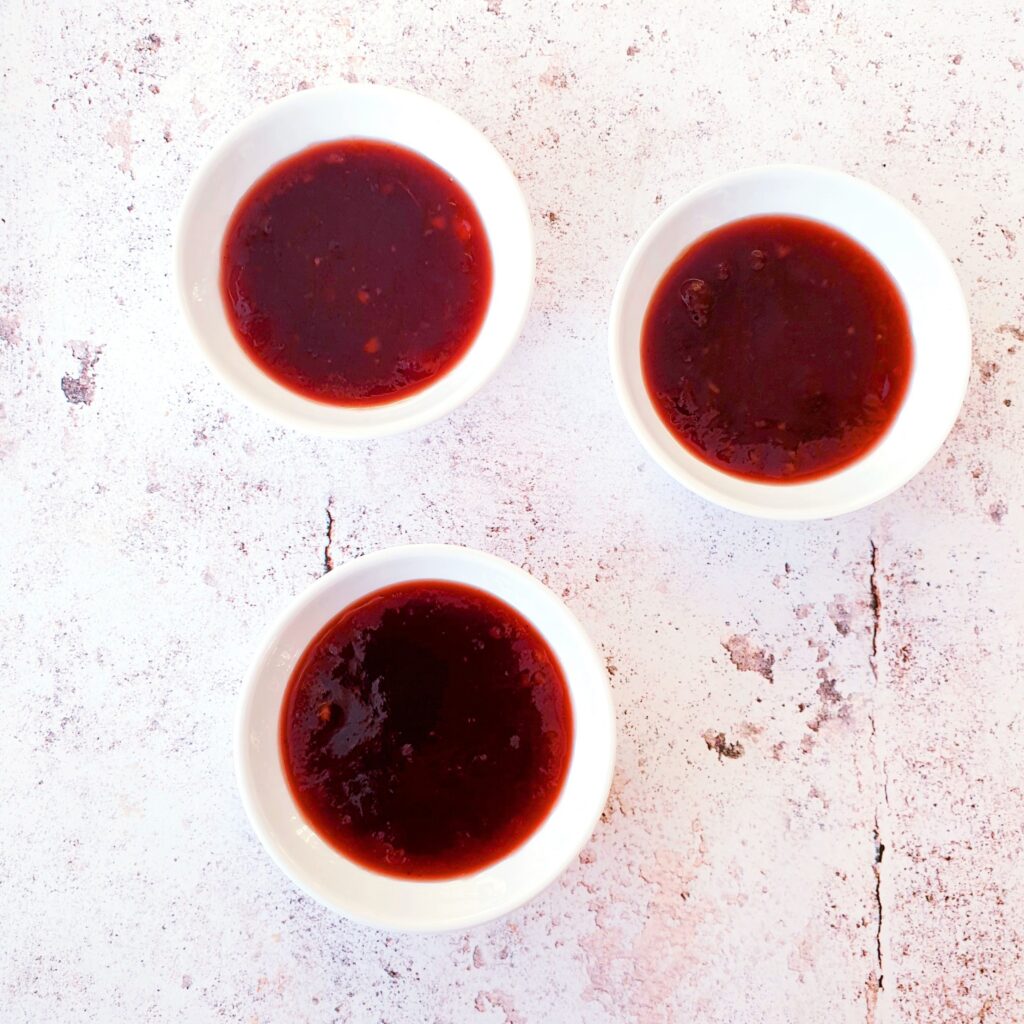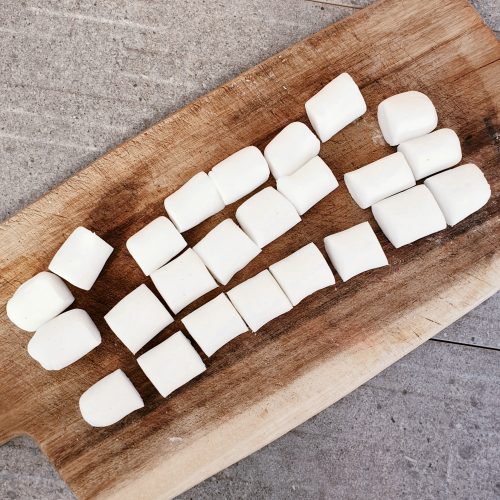Har Gow (ha gau or har gau) are the white skinned prawn dumplings that are my personal highlight on any dim sum platter. They are surprisingly easy, fun to make and much cheaper than buying them ready prepared.

This post may contain affiliate links. Please refer to my Disclosures Page for more details.
I’m not joking, I love these bad boys. To the entirely uninitiated, they may have an odd slippery texture but once the steamed dumpling dough becomes familiar, they are a moorish delight. They really are my go-to dumpling.
I was taught how to make Har Gow dumplings along with Sui Mai and Fun Gao at London Cookery School back in 2017. It was great to learn how to make my favourite prawn dumplings as to be honest, they are very expensive to buy!
As I’ve mentioned in all of my dumpling posts, the list of ingredients does on first glance look sort of long and scary. But everything can easily be bought at any small Asian grocers or even online. I love to head to one of the big Wing Yip superstores every now and again and do a big bulk buy of all the random ingredients.
Har Gow or Ha Gau?
The problem with writing words from a foreign language is that there is rarely one way that people choose to transcribe the sound!
There is only one way of saying Ha Gow (correctly anyway, I’m pretty sure that my Cantonese pronunciation is pretty off!), but many many ways in which it is written.
See also Hummus/Houmous and Poppadom/Pappodom.
Just to confuse matters, Har Gau are also often referred to more simply as “Prawn Dumplings” or “Shrimp Dumplings”.
The important thing to note is that they are all the same thing!

How to Serve Har Gow
Some kind of dipping sauce is essential to serve with Har Gow. This can be as a simple as a little light soy mixed with some rice wine vinegar like in my Dumpling Dipping Sauce.
A sweet chilli sauce also works fabulously, as do all manner of weird and wonderful sauces that I but from Asian grocers or in the world food aisle. My favourite is handily called “Dipping Sauce”!
I often serve Har Gow as part of a wider selection of boiled/fried/steamed dumplings. Sometimes this is accompanied by a simple bowl of miso soup.
Alternatively, I might serve a smaller selection as a starter course before another Asian inspired main course such as my Sweet Chilli Salmon or Korean Pork Belly.

Crockery wise I tend to use my set of Chinese melamine crockery to serve my Asian inspired dishes. I love this set as it is easy to clean, easy to store and brings a smile to my face whenever I bring it out! I’ve bought it in stages to make a full set.
The dumplings themselves are usually served in the steamer baskets they were cooked in. This keeps them nice and hot, just as they should be. Take one to your plate, replace the lid and repeat.
Chopsticks can be tricky to use with the slippery skins but I find that trying is half the fun!
There is no shame in grabbing a fork, or even mucking in and using your fingers. Incidentally, did you know that Sushi is supposed to be eaten with your fingers? Who knew!


Ingredients for Har Gow
Prawn
Any size will do but it is important that they are raw, have no shell and have been deveined. I keep a bag of frozen king prawns in my freezer for dipping into whenever I need some.
Water Chestnut
Water chestnut is readily available in tins in any supermarket. They provide the crunch to the filling and don’t have a hugely strong flavour. You will likely have come across them in your Chinese takeaways.

Wheat Starch
This is important. Wheat starch is not flour. You cannot substitute flour for the wheat starch. This is an ingredient that you can buy in small bags from Asian grocers. It has the texture of cornflour so do be careful that it doesn’t fly everywhere when you open the packet.

Tapioca Flour
This is another ingredient that you will most likely want to buy from an Asian grocers. Saying that, I have seen this in supermarkets labelled as tapioca starch or even cassava flour. It is all the same thing. Tapioca flour also has a very fine consistency.
To find out about more of my favourite Asian Ingredients, check out my guide to the Top 16 Asian Ingredients which I always keep stocked in my pantry.
I’ve also suggested a whole bunch of recipes to try once your cupboard is fully stocked!

Be Flexible
The Har Gow dough is quite specific and this is an occasion when I would suggest that you do not mess with it. The filling can be changed as you wish providing that the consistency is similar to the original.
Other filling options could include scallops (or even lobster if you are feeling decadent). Another white fish would work as would minced meat such as chicken.
The most likely way that you would want to vary the recipe is to change the shape of the dumpling. The pleated skins look amazing and are far more forgiving than you think but there is a knack to it (I have a half knack, they could be a lot neater).
I like persisting and trying as they do eventually start to look neater but it would be perfectly sensible to fold the dumplings into half moons like in my Fun Guo recipe.

Make it Vegetarian or Vegan
The dumpling skin is suitable for vegetarians and vegans.
I have created my Tofu Crystal Dumplings which are a vegan alternative to Har Gow and Fun Guo dumplings. The filling is based around tofu and is super tasty.
Make it Allergy Friendly
This Har Gow recipe is suitable for those who are free from nuts, dairy and egg.
Gluten Free: The only potential gluten containing ingredient in this recipe is the Wheat Starch. Having done some research, it seems that as wheat starch is a processed element of wheat, it contains so little gluten that it is often considered gluten free even for a coeliac diet.
But the advice does vary so please please do your own research and ask anyone that you are cooking for whether they can tolerate wheat starch.
I believe that cornflour is the nearest 100% gluten free substitute and so I would use cornflour with a little xantham gum if the wheat starch cannot be used.
Please note that this recipe may contain other allergens not referred to above and any variations suggested have not been tested unless otherwise stated. For more information regarding any dietary information provided on this website, please refer to my Nutritional Disclaimer.

Equipment Notes for Har Gow
If you don’t have kettle you should buy one immediately. In the meantime, boil the water in a small saucepan. Boil more than you need then measure it once heated. You don’t want to lose water to evaporation and mess up the quantities. Seriously though, buy a kettle.
Whether you choose to roll out your dough on a wooden board, plastic chopping board or your counter top, DO NOT flour the surface. The dough will not stick but flour will change the texture of the dough.

I own a small nylon rolling pin purely for the purpose of making dumplings. It was only a few quid and it is way easier to use than my super heavy marble rolling pin. I would highly recommend tracking one down.
There are various options for steaming the dumplings. I prefer to use bamboo steamers lined with parchment circles. They are easy, quick to clean and balance perfectly on my medium sized saucepan. Using the steamer part of my saucepan set is another option as would be using an electric steamer.
A comprehensive list of the equipment used to make this recipe is included in the main recipe card below. Click on any item to see an example. There are no hard and fast rules so many items can be sensibly substituted to achieve the same results.

Get Ahead
The filling can be prepared up to a day before making the dumplings providing it is properly refrigerated. The filling mix can also be frozen and turned into dumplings at a later time.
The best thing about all of my Chinese Dumpling Recipes is that they can all be made in large batches, frozen and then simply steamed to order straight from frozen.
To freeze the dumplings, lay them out on a baking tray and pop them in the freezer. Try to make sure the dumplings are not touching as much as possible.
Once the dumplings are fully frozen, they can be much more tightly packed into trays or bags and popped back in the freezer in a much smaller space than before.

Leftover Har Gow
To the extent possible I would recommend only cooking as many dumplings as you are likely to eat. Once steamed and cooled, they can be reheated in the microwave or re steamed but they do have a tendency of going a little soggy.
The best way to cook leftover Har Gow is to actually deep fry them. You can reheat the filling whilst making the outer skin much more crisp that you will otherwise achieve. (Actually, I love a deep fried Har Gow!)

Har Gow Tips
The ingredient quantities look quite small. And they are. But the dough is very thin when used so a little really does go a long way.
Do not stress about the pleating. If it stops being fun, stop pleating!
Equally if you have another preferred dumpling fold, try that. There are no hard and fast rules.

Don’t forget to let me know in the comments if you try making this recipe – I want to know what you think and if you made any substitutions, how did it turn out?
Still Have Questions?
Simple! Just contact me and I will do my best to help as quickly as I am able. Head over to my Contact Me page, any of my social media channels or post a comment at the bottom of this page and I’ll see what I can do.
Pin Har Gow (Steamed Chinese Prawn Dumplings) For Later
Hit one of the share buttons to save this page to your Pinterest boards so you can come back and find it at anytime!

Keep Up to Date
Make sure you SUBSCRIBE to my newsletter and avoid missing out on any of my newest and bonus content. Don’t worry, I promise not to spam you or bombard you too often. Plus you’ll receive a copy of my FREE 7 Day International Meal Plan!
Also please don’t forget to follow me over on my social media channels over at Facebook, Twitter, Instagram and Pinterest. I love to interact with my followers and I’d love you to share my content with your friends too.
More Dim Sum Recipes
The Recipe
Har Gow (Steamed Chinese Prawn Dumplings Recipe)
Equipment
Ingredients
For the Filling
- 240 g Raw Prawns (Shrimp)
- 15 g Water Chestnut
- 1 tsp Ginger Paste
- 1.5 tsp Fine Salt
- 1 tbsp Sugar
- 1 tbsp Cornflour (Cornstarch)
- 0.25 tsp White Pepper
For the Dough
- 90 g Wheat Starch
- 60 g Tapioca Flour
- 60 g Cornflour (Cornstarch)
- 1.5 tsp Sugar
- 1 tsp Fine Salt
- 180 g Water
- 1 tbsp Vegetable Oil
Instructions
Prepare the Filling
- Finely chop half of the 240g Raw Prawns. Use the side of a large knife to press the small prawn pieces into the chopping board to make a paste. Set the remaining prawns to the side.
- Finely chop 15g Water Chestnut and add to small mixing bowl along with the minced prawn.
- Add 1 tsp Ginger Paste, 1.5 tsp Fine Salt, 1 tbsp Sugar, 1 tbsp Cornflour and 0.25 tsp White Pepper to the prawn bowl.

- Stir until everything is thoroughly combined.

- Cut the remaining prawns into 30 pieces. It depends on the size of prawn that you use as to how many pieces you will get from each prawn. I use massive prawns which get cut into 6 pieces each. Try to make the pieces as evenly sized as possible.

- Set aside in the fridge whilst making the dough.
Prepare the Dough
- Combine 90g Wheat Starch, 60g Tapioca Flour, 60g Cornflour, 1.5 tsp Sugar and 1 tsp Fine Salt in a medium bowl.

- Add 180g Boiling Water. Mix quickly for only 20 seconds then cover the bowl and leave for 3 minutes. This 'cooks' the flour.

- Add 1 tbsp Vegetable Oil to the dough and knead until very smooth. This doesn't take long at all.

- And it goes VERY smooth.

- Divide the dough into thirds, roll each chunk into a thick sausage and then divide each sausage into 8 equal pieces. (Please note you will need to make adjustments if you have changed the portions for this recipe) You should end up with 24 pieces in total. You will use offcuts to make the remaining dumplings.

- Keep the dough balls in a plastic bag with the top kept tightly wound to stop them from drying out.
Assemble the Dumplings
- Assemble the prawn paste, prawns, dough pieces, rolling pin, board and cookie cutter in one place.

- Roll out one of the dough balls to about 0.5mm thick.

- Keep turning and flipping the dough to prevent it sticking. Do not use flour or oil.

- Cut out a round with a smooth edged 3.5 inch cookie cutter.

- Squeeze the cuttings together and place back in the plastic bag with the rest of the dough.
- Add about half a teaspoon of the prawn paste to the dough round and top with a piece of prawn.

- Loosely fold the dough over the filling. Do not squeeze the edges together.

- Hold the dough in your left hand (or right if you are left handed). The bulk of the dough will rest on your left index finger with the gap pointing away from you. Your thumb will anchor the dumpling to your hand.
- Use your right hand to create pleats by folding the top of the dough back on itself in stages whilst at the same time pinching the layers of dough together.

- This action is very difficult to describe but fun to master! You can alternatively not pleat the dumplings and just press the edges together to make half moons. They will taste the same!

- Keep folding pleats into the dumpling…

- …until you run out of dough.

- Squeeze the top edge of the dough together to fully seal it.

- You don’t want any of the filling to be able to escape.

- Place the folded dumpling onto a board or tray and continue to repeat with the other balls of dough.

- There should be some filling left so squeeze together all the off cuts and roll them out to form as many extra dumplings as you can. You should be able to make a further 6 dumplings.
To Steam the Dumplings:
- To cook the dumplings, place them in a steamer basket and cook for 8 minutes over boiling hot water. To cook from frozen, allow 12 minutes.




































Monika Dabrowski says
Don’t delete this, it’s actually me this time:) I am so impressed you made this recipe from scratch, not just the filling but the pastry too. They look so authentic!
Chloe says
Ha ha I love that you actually came and commented. You’re awesome! Just a shame you didn’t make them for your party last night!!!!
Monika says
Wow wow wow! This recipe is awesome and easy to prepare! Yesterday, I threw a party at my home and prepared this recipe. Everyone just loved the recipe. Thanks much for sharing this!
Eb Gargano | Easy Peasy Foodie says
OK now I am really craving these – they look and sound awesome! And love how easy you’ve made it look. Not convinced I could ever make them look quite as good as yours, though. Eb x
Chloe says
I only make it look easy because it is! Plus, not matter how bad they look uncooked, they magically still look amazing after steaming!
Veronica says
OMG – I have to make these. You make it look so easy. I lived on these things when I visited Taiwan and I’ve been meaning to try making my own, but never got round to it. I’ve made out a shopping list and Saturday has been marked up in my calendar!!!!
Chloe says
Brilliant – I can’t wait to hear how it goes. I find it really therapeutic to get in the zone with my folding. Just beware of long nails – they are your dumpling folding enemy!
Corina Blum says
I’ve only made my own dumplings once and never my own wrappers too! These sound delicious and would be lovely if I ever feel like a bit of experimenting.
Chloe says
I do use store bought wrapper for siu mai and wontons etc but I’ve never seen crystal dumpling dough to buy. So its make your own or bust for these ones! Its such a lovely dough to work with though – its no hardship!